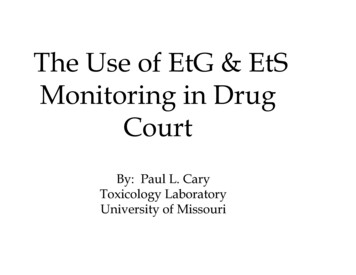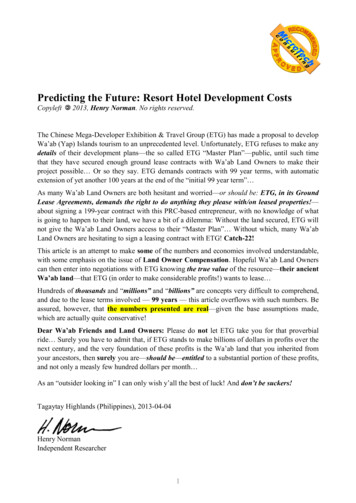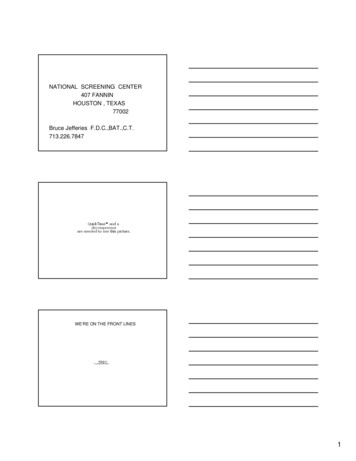
Transcription
The Use of EtG & EtSMonitoring in DrugCourtBy: Paul L. CaryToxicology LaboratoryUniversity of Missouri
Current alcohol testing issues: “legal” drug - without prescriptionscreening tests specific for ethanol, ethyl alcoholurine, blood, saliva or breathpositive results indicate presence alcoholalcohol is rapidly cleared from the bodynegative results don’t necessarily documentabstinencedetection time hourstransdermal detection - SCRAM
Problems Associated withMonitoring Clients for Alcohol short detection window (hours)current specimens: blood (invasive) urine (tampering issues) breath/saliva (for best results requireson-site field visits)urine - fermentation
Promise of EtG/EtS TestingAlcohol is the most commonlyabused substance by drug courtclients yet the most difficultsubstance to detect via abstinencemonitoring when attempting todetect alcohol.
EtG ethyl glucuronideEtS ethyl sulfate
Advantages of EtG & EtS unique biological marker of alcohol use (nofalse positives)direct marker indicating recent uselonger detection window than alcoholstable in stored specimens (non-volatile)is not formed by fermentationis not detected in the urine of abstinentsubjects
Extending the detection window
EtG/EtS Testing is Specific numerous types of “alcohol”isopropanol, isopropyl alcohol (“rubbingalcohol”)methanol, methyl alcoholacetone (nail polish remover)beverage alcohol is ethyl alcohol (ethanol)EtG/EtS testing is specific for the alcohol inalcoholic beverages
Disadvantages of Ethyl Glucuronide testing available at relatively few laboratoriesEtG/EtS testing more costly than abused drugs expensive LC/MS/MS technologynot a quantitative determinationmost significant concern – casual, inadvertent,environmental alcohol exposure causing positiveresults
A bit of history:September 25, 2006, the U.S. Department ofHealth and Human Services released anadvisory from the Center for Substance AbuseTreatment (CSAT) entitled:The Role of Biomarkersin the Treatment of AlcoholUse Disorders
“Currently, the use of an EtG test in determiningabstinence lacks sufficient proven specificity for use asprimary or sole evidence that an individual prohibitedfrom drinking, in a criminal justice or a regulatorycompliance context, has truly been drinking. Legal ordisciplinary action based solely on a positive EtG, orother test discussed in this Advisory, is inappropriateand scientifically unsupportable at this time. These testsshould currently be considered as potential valuableclinical tools, but their use in forensic settings ispremature.”
Sources of “Incidental” Alcohol Exposure OTC medications (Nyquil, Vicks 44)mouthwashes (Listermint, Scope, Cepacol)herbal/homeopathic medications (i.e., tinctureof gingko biloba - memory)foods containing alcohol (such as vanillaextract, baked Alaska, cherries jubilee, etc.)“non-alcoholic” beers (O’Doul’s, Sharps)colognes & body spraysinsecticides (DEET)alcohol-based hand sanitizers (Purell, GermX)
Nyquil Dosing StudyConcentration (ng/mL)3002001 Nyquil dose1 Nyquil dose1001 Nyquil dose012.755.7512.005.836.470.00Collection Time (hours)Subject 0007
Sources of “Incidental” Alcohol Exposure OTC medications (Nyquil, Vicks 44)mouthwashes (Listermint, Scope, Cepacol)herbal/homeopathic medications (i.e., tinctureof gingko biloba - memory)foods containing alcohol (such as vanillaextract, baked Alaska, cherries jubilee, etc.)“non-alcoholic” beers (O’Doul’s, Sharps)colognes & body spraysinsecticides (DEET)alcohol-based hand sanitizers (Purell, GermX)
The Mouthwash Studies: mouthwash study (whole bottle) - highest EtG onesample over 300 ng/mL - total of 39 samplesmouthwash study (30 seconds, 3X per day, five days)- no EtG over 120 ng/mL - total of 55 samplesmouthwash study (30 seconds, every hour for 8hours) - highest EtG 336 ng/mL EtS 73 ng/mLmouthwash 27% (Listerine “original”) - 4 times daily- 4 days - highest EtG 173 ng/mL, highest EtS 104 ng/mL
Sources of “Incidental” Alcohol Exposure OTC medications (Nyquil, Vicks 44)mouthwashes (Listermint, Scope, Cepacol)herbal/homeopathic medications (i.e., tinctureof gingko biloba - memory)foods containing alcohol (such as vanillaextract, baked Alaska, cherries jubilee, etc.)“non-alcoholic” beers (O’Doul’s, Sharps)colognes & body spraysinsecticides (DEET)alcohol-based hand sanitizers (Purell, GermX)
Alcohol in Food - Cook’s Illustrated Study(2005) “A Few Sobering Thoughts” beef burgundy - three hours in oven, lid on, 40%alcohol retained flambéflamb recipes - igniting brandy over high heat 29%alcohol retained - igniting brandy in cold pan 57%alcohol retained
Sources of “Incidental” Alcohol Exposure OTC medications (Nyquil, Vicks 44)mouthwashes (Listermint, Scope, Cepacol)herbal/homeopathic medications (i.e., tinctureof gingko biloba - memory)foods containing alcohol (such as vanillaextract, baked Alaska, cherries jubilee, etc.)“non-alcoholic” beers (O’Doul’s, Sharps)colognes & body spraysinsecticides (DEET)alcohol-based hand sanitizers (Purell, GermX)
AVERAGE ALCOHOL AND CALORIE CONTENT OFREGULAR, LIGHT, AND NON-ALCOHOLIC BEERProductNo.% AlcoholCaloriessamplesper 100 ---------Regular1635.0 [2.0-9.5]43 [26-83]Light264.1 [2.4-5.4]32 [19-43]Nonalcoholic130.3 [0.1-0.7]17 ---------------
Ethyl Glucuronide Concentration Levels in Human Urine afterconsumption of 2 O'Douls Non-Alcoholic Beverages100Concentration (ng/mL)908070605040Subject 0035302010013.0010.006.503.001.000.00Hours Between Last Drink and Collection
Sources of “Incidental” Alcohol Exposure OTC medications (Nyquil, Vicks 44)mouthwashes (Listermint, Scope, Cepacol)herbal/homeopathic medications (i.e., tinctureof gingko biloba - memory)foods containing alcohol (such as vanillaextract, baked Alaska, cherries jubilee, etc.)“non-alcoholic” beers (O’Doul’s, Sharps)colognes & body spraysinsecticides (DEET)alcohol-based hand sanitizers (Purell, GermX)
The Hand Sanitizer Studies: hand sanitizer study (every 15 minutes , 8 hours) highest EtG 62 ng/mL In closed room - one subject 350 ng/mL of EtGhand sanitizer study (1X, every 8 hours) - highestEtG 103 ng/mL EtS 51 ng/mLNOTE: 11 subjects, 62% alcohol, every 5 minutes, forten hours, for 3 consecutive days - highest EtG 2001 ng/mL, EtS 84 ng/mL
The Inhalation Study: 50 mL of ethanol into beaker, the beaker wasswirled to wet the sides and promotevaporization, the beaker was held up to the noseand 1 deep respiration of vapor was performedevery five minutes for one hour (X 12)inhalation study - highest EtG 124 ng/mL EtS 13 ng/mL
On May 20, 2012 . . .
What This Advisory Is and Isn’t not revolutionaryis incremental progress report state of thescienceis tempered versus stridentis clinically-oriented: word “patient” used 14times“forensic” “legal” “criminal” “justice” do notappear
What This Advisory Is and Isn’t not a legal/forensic documentis treatment documentlegal justification for EtG/EtS testing - caselaw, evidential hearings & judicial rulingsnew advisory adds support for the use ofEtG/EtS as a recovery toolnot a roadblock to current drug court policies &practices
The EtG/EtS CutoffIssue
EtG Cutoff Carnival: EtG cutoffs of 100 - 250 ng/mL likely to low forcriminal justiceEtG cutoff of 2000 ng/mL likely to high foreffective abstinence monitoringGoldilocks cutoff for EtG is 500 ng/mL - just right! up to 48 hour detection window avoids sources of "incidental" exposure consistent with “preponderance of theevidence” admissibility standard
2012 Advisory EtG Cutoff levels Jatlow & O’Malley (2010) “Clinical (non forensic)Application of EtG Measurement” 1000 ng/mL “heavy drinking” prior 48 hours500 - 1000 ng/mL previous heavy drinking (1 - 3 days) recent light drinking (prior 24 hours) recent intense “extraneous” exposure (within 24hours)
2012 Advisory EtG Cutoff levels 100 - 500 ng/mL previous heavy drinking (1 - 3 days) previous light drinking (12 - 36 hours) recent “extraneous” exposureconsensus EtG cutoff level currently used by mostdrug courts 500 ng/mLno inconsistency with revised Advisory based upon“preponderance” standardadmissibility enhanced with addition of EtS andclient contract
Forensic Cutoff: EtG minimum of 500 ng/mL EtS minimum of 100 ng/mL
Positive EtG/EtS Result (500/100ng/mL): is consistent with the recent ingestion of alcoholcontaining products (1-2 days prior to specimencollection) by a monitored clientstudies examining “extraneous” exposure widelyconclude that results in excess of the 500/100 ng/mLcutoffs are not associated with “environment” alcoholsourcesmeets “preponderance of the evidence” standard
Negative EtG/EtS Result (500/100ng/mL):a result reported as EtG negative isindicative of a client who has not ingestedbeverage alcohol within 1-2 days prior tospecimen collection a negative result is not proof of abstinence
20062012
2012 Advisory EtG/EtS TestingMethodologies no on-site testing devices – “rapid” or “instant”testsLC/MS/MS - recognized reference methodGC/MS also recommendedautomated method for use on auto-analyzers andother drug testing instrumentation no EtS testing confirmation ?
Advisory’s Stance on TestingMethods EtG/EtS best measured in urinehair & nail testing problematic (undefined detectionwindow)recommends GC/MS or LC/MS/MSimmunoassay tests may produce “false positives”resultsconfirm results of positive screening tests
If your court is using an EtG“screening” test (enzymeimmunoassay) - confirm positiveresults using the LC/MS/MS.
Why Drug Courts Should UseEtG/EtS
More Researchdefine & establish cutoffs identify influencing factors (genetics, age,gender, ethnic groups, disease, etc.) how detection window effected by varyinglevels of alcohol use establish reliability of laboratory testing determine commercial product influence
Best Practices for EtG/EtS Testing:provide those being monitored withan alcohol use advisory document EtG/EtS specific contract - mandatory use appropriate cutoffs: EtG - 500 ng/mL EtS - 100 ng/mL test for EtS (ethyl sulfate) - biomarkerof choice
EtG/EtS- Specific Contract: outlines the behavioral requirements andcompliance standards necessary for continuedparticipation in drug courteducate, alert and advise drug court clients of thepotential (incidental) sources of alcohol that couldproduce a positive urine EtG/EtS test resultlisting the numerous commercial products thatcontain ethyl alcohol and provides a list ofsubstances to avoid while in a drug court program
Prohibited Items:OTC medications non-alcoholic beer & wine foods that contain alcohol alcohol-based mouthwashes alcohol-based hand sanitizers alcohol-based hygiene products
When in doubt,don’t use, consumeor apply!
Best Practices for EtG/EtS Testing:provide those being monitored withan alcohol use advisory document EtG/EtS specific contract - mandatory use appropriate cutoffs: EtG - 500 ng/mL EtS - 100 ng/mL test for EtS (ethyl sulfate) - biomarkerof choice
Is a positive urine EtG/EtS testresult a definitive indicator ofrelapse or prohibited drinking?Is a positive urine EtG/EtS testresult sufficient justification forclient sanctioning?
EtG/EtS Admissibility?are EtG/EtS results legally admissible Kelly-Frye, Daubert, Rule 703 use of proper cutoffs 500/100 ng/mL use of appropriate methodologies(LC/MS/MS for confirmation of positives)use client contractinterpret results correctlyYES!
Client InterventionStrategies
Options for Client Sanctioning: positive result - cutoff of at least 500/100ng/mLcombined with:a client admission of use/relapseidentification of behavioral indicators alcohol-related arrest or incident alcohol-related job action client seen in bar/taverna violation of EtG-specific contract
Response to Positive WITHOUTself-admission: sanction based upon current court policiesintensify alcohol abstinence monitoring breath testing SCRAM more EtG/EtSincrease in supervision strategiessupervised Antabuse (Disulfiram)
Miscellaneous Issues
EtG & Bacteria: EtG is a more labile compound than EtSrecent studies indicate that EtG can bedestroyed by certain bacteria resulting in anegative EtG and a positive EtSEtS is not susceptible to bacterialdegradationresult indicating a positive EtS is sufficientto document covert alcohol ingestion
Millennium - Synergy Synergy contains kombucha fermented mixture of fungi, bacteria,black tea and sugar product contains about 0.5% ethylalcohol similar % to non-alcoholic beer
Current State of EtG/EtS Testing inDrug Courts reliable & accurate approach to alcohol abstinencemonitoring supported by the scienceEtG/EtS valuable tool for therapeutic intervention EtS more stableprovide clients with alcohol avoidance informationuse positive EtG/EtS results to leverage selfadmissionsif using EtG screening - use LC/MS/MS method forconfirmationemploy appropriate cutoff levelsuse results to support recovery
EtG/EtS testing may be the bestalcohol abstinence monitoringtool EVER!Not a silver bullet.
email address: carypl@health.missouri.edu
participation in drug court educate, alert and advise drug court clients of the potential (incidental) sources of alcohol that could produce a positive urine EtG/EtS test result listing the numerous commercial products that contain ethyl alcohol and provides a list of substances to avoid while in a drug court program










